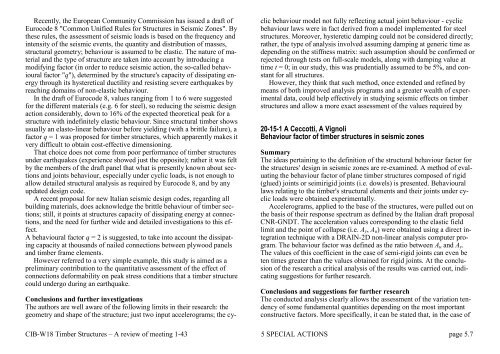CONTENT 5.1 SEISMIC BEHAVIOUR ... - CIB-W18
CONTENT 5.1 SEISMIC BEHAVIOUR ... - CIB-W18
CONTENT 5.1 SEISMIC BEHAVIOUR ... - CIB-W18
You also want an ePaper? Increase the reach of your titles
YUMPU automatically turns print PDFs into web optimized ePapers that Google loves.
Recently, the European Community Commission has issued a draft of<br />
Eurocode 8 "Common Unified Rules for Structures in Seismic Zones". By<br />
these rules, the assessment of seismic loads is based on the frequency and<br />
intensity of the seismic events, the quantity and distribution of masses,<br />
structural geometry; behaviour is assumed to be elastic. The nature of material<br />
and the type of structure are taken into account by introducing a<br />
modifying factor (in order to reduce seismic action, the so-called behavioural<br />
factor "q"), determined by the structure's capacity of dissipating energy<br />
through its hysteretical ductility and resisting severe earthquakes by<br />
reaching domains of non-elastic behaviour.<br />
In the draft of Eurocode 8, values ranging from 1 to 6 were suggested<br />
for the different materials (e.g. 6 for steel), so reducing the seismic design<br />
action considerably, down to 16% of the expected theoretical peak for a<br />
structure with indefinitely elastic behaviour. Since structural timber shows<br />
usually an elasto-linear behaviour before yielding (with a brittle failure), a<br />
factor q = 1 was proposed for timber structures, which apparently makes it<br />
very difficult to obtain cost-effective dimensioning.<br />
That choice does not come from poor performance of timber structures<br />
under earthquakes (experience showed just the opposite); rather it was felt<br />
by the members of the draft panel that what is presently known about sections<br />
and joints behaviour, especially under cyclic loads, is not enough to<br />
allow detailed structural analysis as required by Eurocode 8, and by any<br />
updated design code.<br />
A recent proposal for new Italian seismic design codes, regarding all<br />
building materials, does acknowledge the brittle behaviour of timber sections;<br />
still, it points at structures capacity of dissipating energy at connections,<br />
and the need for further wide and detailed investigations to this effect.<br />
A behavioural factor q = 2 is suggested, to take into account the dissipating<br />
capacity at thousands of nailed connections between plywood panels<br />
and timber frame elements.<br />
However referred to a very simple example, this study is aimed as a<br />
preliminary contribution to the quantitative assessment of the effect of<br />
connections deformability on peak stress conditions that a timber structure<br />
could undergo during an earthquake.<br />
Conclusions and further investigations<br />
The authors are well aware of the following limits in their research: the<br />
geometry and shape of the structure; just two input accelerograms; the cy-<br />
clic behaviour model not fully reflecting actual joint behaviour - cyclic<br />
behaviour laws were in fact derived from a model implemented for steel<br />
structures. Moreover, hysteretic damping could not be considered directly;<br />
rather, the type of analysis involved assuming damping at generic time as<br />
depending on the stiffness matrix: such assumption should be confirmed or<br />
rejected through tests on full-scale models, along with damping value at<br />
time t = 0; in our study, this was prudentially assumed to be 5%, and constant<br />
for all structures.<br />
However, they think that such method, once extended and refined by<br />
means of both improved analysis programs and a greater wealth of experimental<br />
data, could help effectively in studying seismic effects on timber<br />
structures and allow a more exact assessment of the values required by<br />
20-15-1 A Ceccotti, A Vignoli<br />
Behaviour factor of timber structures in seismic zones<br />
Summary<br />
The ideas pertaining to the definition of the structural behaviour factor for<br />
the structures' design in seismic zones are re-examined. A method of evaluating<br />
the behaviour factor of plane timber structures composed of rigid<br />
(glued) joints or seimirigid joints (i.e. dowels) is presented. Behavioural<br />
laws relating to the timber's structural elements and their joints under cyclic<br />
loads were obtained experimentally.<br />
Accelerograms, applied to the base of the structures, were pulled out on<br />
the basis of their response spectrum as defined by the Italian draft proposal<br />
CNR-GNDT. The acceleration values corresponding to the elastic field<br />
limit and the point of collapse (i.e. Ay, Au) were obtained using a direct integration<br />
technique with a DRAIN-2D non-linear analysis computer program.<br />
The behaviour factor was defined as the ratio between Au and Ay.<br />
The values of this coefficient in the case of semi-rigid joints can even be<br />
ten times greater than the values obtained for rigid joints. At the conclusion<br />
of the research a critical analysis of the results was carried out, indicating<br />
suggestions for further research.<br />
Conclusions and suggestions for further research<br />
The conducted analysis clearly allows the assessment of the variation tendency<br />
of some fundamental quantities depending on the most important<br />
constructive factors. More specifically, it can be stated that, in the case of<br />
<strong>CIB</strong>-<strong>W18</strong> Timber Structures – A review of meeting 1-43 5 SPECIAL ACTIONS page 5.7














